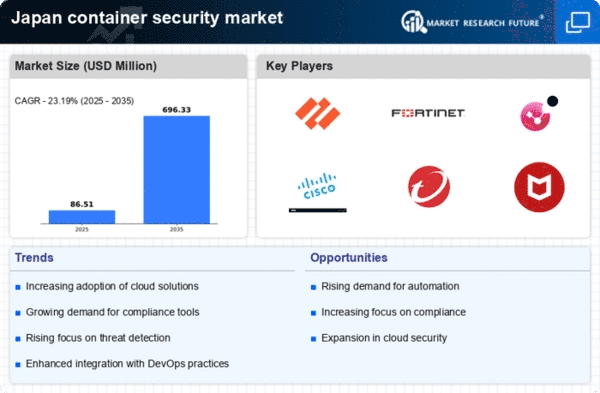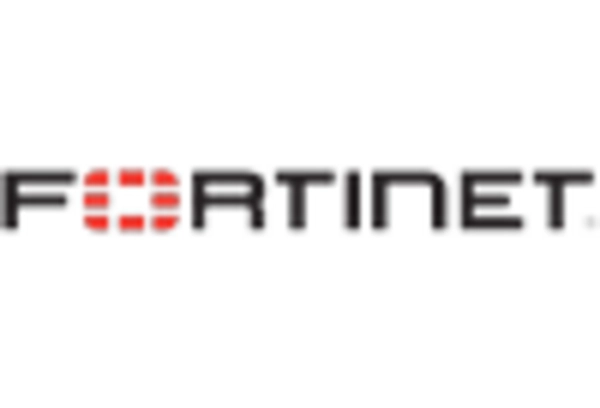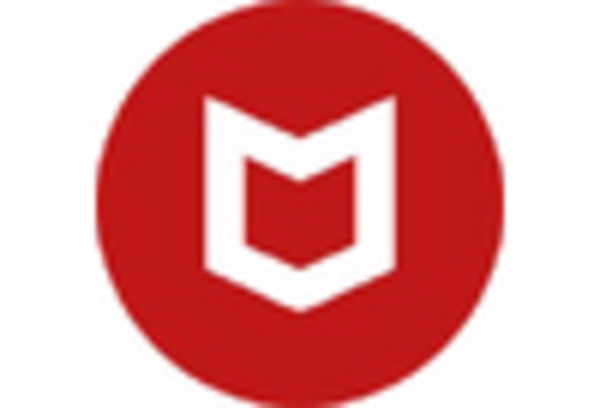Rising Cybersecurity Threats
The container security market in Japan is experiencing heightened demand due to the increasing frequency and sophistication of cyber threats. As organizations migrate to containerized environments, they become more vulnerable to attacks such as data breaches and ransomware. In 2025, it is estimated that cybercrime could cost the global economy over $10 trillion annually, prompting Japanese companies to invest heavily in security solutions. This trend indicates a growing recognition of the need for robust container security measures to protect sensitive data and maintain operational integrity. Consequently, the container security market is likely to expand as businesses prioritize cybersecurity investments to mitigate risks associated with container deployments.
Adoption of Cloud-Native Technologies
The shift towards cloud-native technologies is significantly influencing the container security market in Japan. As enterprises increasingly adopt cloud services, the need for effective security solutions tailored to containerized applications becomes paramount. In 2025, the cloud computing market in Japan is projected to reach approximately $20 billion, driving demand for container security solutions that can seamlessly integrate with cloud environments. This trend suggests that organizations are seeking to enhance their security posture while leveraging the scalability and flexibility of cloud-native architectures. As a result, the container security market is poised for growth as businesses look to secure their cloud-based applications and data.
Increased Focus on Supply Chain Security
The container security market in Japan is witnessing a surge in interest due to the growing emphasis on supply chain security. Recent incidents have highlighted vulnerabilities within supply chains, prompting organizations to reassess their security strategies. In 2025, it is anticipated that 70% of companies in Japan will prioritize supply chain security, leading to increased investments in container security solutions. This focus on securing the supply chain indicates a broader recognition of the interconnectedness of digital ecosystems and the potential risks associated with containerized applications. Consequently, the container security market is likely to benefit from this heightened awareness and investment in comprehensive security measures.
Regulatory Pressures and Compliance Requirements
The container security market in Japan is significantly influenced by regulatory pressures and compliance requirements. As data protection laws become more stringent, organizations are compelled to adopt security measures that align with these regulations. In 2025, it is expected that compliance-related investments will account for over 30% of total IT security spending in Japan. This trend underscores the necessity for container security solutions that not only protect data but also ensure compliance with evolving legal frameworks. As businesses navigate these regulatory landscapes, the container security market is likely to see increased demand for solutions that facilitate compliance while safeguarding containerized applications.
Growing Demand for Automation in Security Processes
The container security market in Japan is experiencing a shift towards automation in security processes. As organizations strive for efficiency and speed in their development cycles, the integration of automated security solutions becomes essential. In 2025, it is projected that automated security tools will account for nearly 40% of the total security market in Japan. This trend suggests that businesses are increasingly recognizing the value of automating security measures to enhance their container security posture. Consequently, the container security market is likely to expand as organizations seek to implement automated solutions that streamline security processes while maintaining robust protection for their containerized environments.

















Leave a Comment